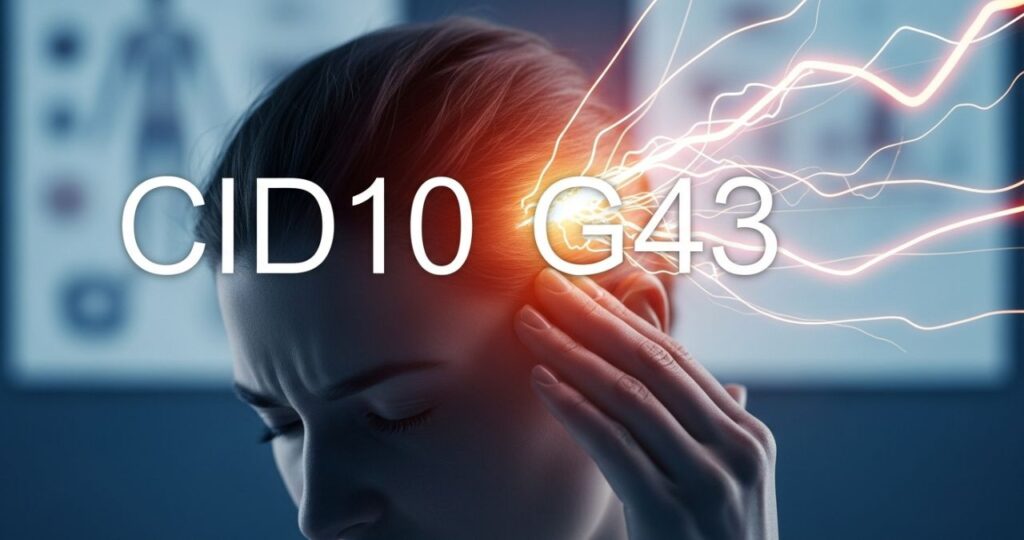CID10G43 is the ICD-10 medical code for migraine—a neurological condition causing recurring, severe headaches. This code classifies your condition in a global healthcare system, helping doctors document your diagnosis accurately and ensuring you receive proper treatment and insurance coverage.
When your doctor mentions CID10G43 in your medical report, it might sound cryptic. But this code is your gateway to better migraine care. If you’ve been dealing with intense headaches that disrupt your life, understanding what CID10G43 represents can help you take control of your health journey.
What CID10G43 Actually Means
CID10G43 comes from the International Classification of Diseases, 10th Revision (ICD-10). “CID” stands for “Classificação Internacional de Doenças”—the Portuguese term for this global health coding system. The “G43” points to the specific category within neurological disorders dedicated to migraines.
This isn’t just medical jargon. Around 1.16 billion people worldwide deal with migraines, making it one of the most common neurological conditions you can face. Your doctor uses CID10G43 to officially document that your recurring headaches meet the clinical definition of migraine, separating them from regular tension headaches or other pain conditions.
The code breaks down further into subtypes. G43.0 covers migraines without aura—the most common form. G43.1 addresses migraines with aura, where you experience visual disturbances before the pain hits. There are also codes for chronic migraine (G43.7), status migrainosus (G43.2), and other specific variations.
Why This Code Matters for Your Care
You might wonder why healthcare professionals bother with codes at all. Here’s the reality: CID10G43 directly impacts the quality of care you receive.
First, it creates consistency. Whether you visit a neurologist in London or a clinic in São Paulo, medical staff will understand your condition immediately. Your medical records travel with you, maintaining clarity across different healthcare systems.
Second, insurance companies rely on CID10G43 to process claims. A vague description like “bad headaches” won’t justify coverage for specialized migraine medications or imaging tests. But a documented CID10G43 diagnosis opens doors to triptans, preventive treatments, and even newer CGRP inhibitors that can cost hundreds of dollars per month.
Third, this code fuels research. When researchers track CID10G43 cases globally, they identify patterns, develop better treatments, and allocate public health resources where they’re needed most. Your diagnosis contributes to a larger understanding of this condition.
Types of Migraines Under CID10G43
Not all migraines look the same. The CID10G43 classification recognizes several distinct types:
- Migraine without aura affects about 70% of migraine sufferers. You’ll feel intense, throbbing pain—usually on one side of your head—lasting four to 72 hours. Nausea, vomiting, and sensitivity to light or sound typically come along for the ride.
- Migraine with aura starts differently. Before the headache begins, you might see flashing lights, zigzag patterns, or experience tingling sensations. Some people temporarily lose vision in part of their visual field. These warning signs usually last 20 to 60 minutes before the pain phase kicks in.
- Chronic migraine means you’re dealing with headaches on 15 or more days per month, with at least eight of those days meeting migraine criteria. This subtype significantly impacts daily functioning and often requires more intensive treatment approaches.
- Vestibular migraine adds dizziness and balance problems to the mix. You might feel like the room is spinning or struggle to walk steadily, even without a severe headache.
Each type requires tailored management strategies, which is why accurate classification under CID10G43 makes such a difference in treatment outcomes.
What Triggers Your CID10G43 Condition
Migraines remain somewhat mysterious, but researchers have identified clear patterns. Your brain’s abnormal activity affects nerve signals and blood vessels, creating the perfect storm for an attack.
Hormonal fluctuations trigger migraines in many women, particularly around menstruation, pregnancy, or menopause. Stress ranks as the most commonly reported trigger—roughly 60% of people with CID10G43 diagnoses point to stress as their main culprit.
Sleep matters more than you might think. Too little sleep, too much sleep, or irregular sleep patterns can all provoke attacks. Dehydration works similarly—your brain needs consistent hydration to function properly.
Certain foods deserve attention. Aged cheeses, processed meats containing nitrates, alcohol (especially red wine), and foods with MSG frequently appear on trigger lists. Caffeine creates a paradox: it can both help stop a migraine and trigger one if you consume too much or suddenly cut back.
Environmental factors play their part. Bright lights, loud noises, strong smells, and even weather changes can set off an episode. Some people track barometric pressure changes because they consistently trigger their migraines.
Genetics influences your risk significantly. If migraines run in your family, your chances of developing CID10G43-related symptoms increase substantially.
How Doctors Diagnose CID10G43
No single test confirms migraine. Instead, your doctor relies on your symptom history and a thorough clinical evaluation.
Expect detailed questions about your headache patterns: How often do they occur? How long do they last? What does the pain feel like? Do you experience any warning signs? What makes the pain worse or better?
Keeping a headache diary before your appointment proves incredibly helpful. Note the date and time each headache starts, its duration, intensity on a scale of 1-10, associated symptoms, and any potential triggers you noticed.
Your doctor will perform a neurological examination, checking your reflexes, coordination, sensation, and mental function. This helps rule out other conditions that might mimic migraines.
Imaging tests like MRI or CT scans aren’t routine for migraine diagnosis. They’re reserved for situations where something unusual appears—sudden onset after age 50, rapidly worsening headaches, or concerning neurological symptoms that don’t fit typical migraine patterns.
Once your symptoms align with established diagnostic criteria, your doctor applies the CID10G43 code to your medical record. This formal classification becomes the foundation for your treatment plan.
Treatment Options for CID10G43 Migraines
Managing migraines requires a two-pronged approach: stopping attacks when they happen and preventing future episodes.
1. Acute treatments
Acute treatments work best when you take them early. Over-the-counter options like ibuprofen or naproxen can handle mild to moderate attacks. Triptans—prescription medications that target serotonin receptors—remain the gold standard for moderate to severe migraines. Newer options include ditans and gepants, which work through different mechanisms.
2. Anti-nausea medications
Anti-nausea medications often accompany pain relievers, addressing one of migraine’s most debilitating symptoms. Some people benefit from combining medications for better results.
3. Preventive treatments
Preventive treatments make sense if you’re dealing with frequent or severe attacks. Beta-blockers, originally developed for heart conditions, can reduce migraine frequency. Certain antidepressants and anti-seizure medications also show preventive benefits.
4. CGRP inhibitors
CGRP inhibitors represent a breakthrough in migraine prevention. These newer medications specifically target the calcitonin gene-related peptide involved in migraine attacks. Monthly injections or oral pills can dramatically reduce attack frequency for many people.
5. Botox injections
Botox injections received FDA approval for chronic migraine, administered every 12 weeks across specific head and neck locations.
6. Lifestyle modifications
Lifestyle modifications complement medical treatments. Regular sleep schedules, consistent meal times, adequate hydration, stress management techniques, and regular exercise all contribute to better migraine control.
Alternative therapies deserve consideration. Acupuncture shows promise in clinical trials. Biofeedback helps you learn to control certain body functions that might influence migraines. Cognitive behavioral therapy addresses the psychological aspects of chronic pain.
Living Well with a CID10G43 Diagnosis
A CID10G43 diagnosis doesn’t mean accepting a diminished quality of life. With proper management, many people reduce their attack frequency and severity significantly.
- Build a support system. Family members who understand your condition can provide crucial assistance during attacks. Online communities connect you with others who genuinely understand what you’re experiencing.
- Communicate with your employer about your condition. Many workplaces offer accommodations like flexible scheduling, quiet work spaces, or the ability to work from home during bad days.
- Track your progress. Note which treatments help, which triggers to avoid, and how your overall pattern changes over time. This information helps your healthcare team adjust your treatment plan.
- Stay informed about new developments. Migraine research advances rapidly, with new medications and treatment approaches emerging regularly. What wasn’t available last year might be an option now.
- Don’t hesitate to seek specialized care. If your primary care doctor’s treatment approach isn’t working, a neurologist or headache specialist might offer additional options you haven’t tried yet.
The Global Impact of CID10G43
Looking beyond individual experiences, migraines create substantial public health challenges. Approximately 40% of the global population experiences some form of headache disorder, with migraines accounting for a significant portion.
Migraines rank third globally in causing disability-adjusted life years—a measure combining years lost to illness, disability, or early death. Among women aged 15-49, migraines stand as the leading cause of disability worldwide.
The economic burden extends beyond healthcare costs. Lost productivity, missed work days, and reduced effectiveness on the job add up. Women bear the brunt of this burden, experiencing migraines three times more frequently than men.
Despite affecting over a billion people, migraines remain underfunded and underrecognized compared to other neurological conditions. Many countries lack specialized headache services, and even where care exists, access remains limited.
The ICD-10-G43 code helps address these gaps by creating standardized data collection. When health ministries see concrete numbers showing migraine’s impact on their populations, they can allocate resources more effectively and develop targeted public health interventions.
Taking the Next Step
If you’ve received a CID10G43 diagnosis, you’re not alone in this journey. More than one in seven people worldwide shares this condition. The code on your medical record represents more than just a classification—it connects you to a global network of research, treatment options, and ongoing care improvements.
Work closely with your healthcare provider to develop a personalized treatment plan. What works for one person might not work for another, so expect some trial and error as you find your optimal approach.






